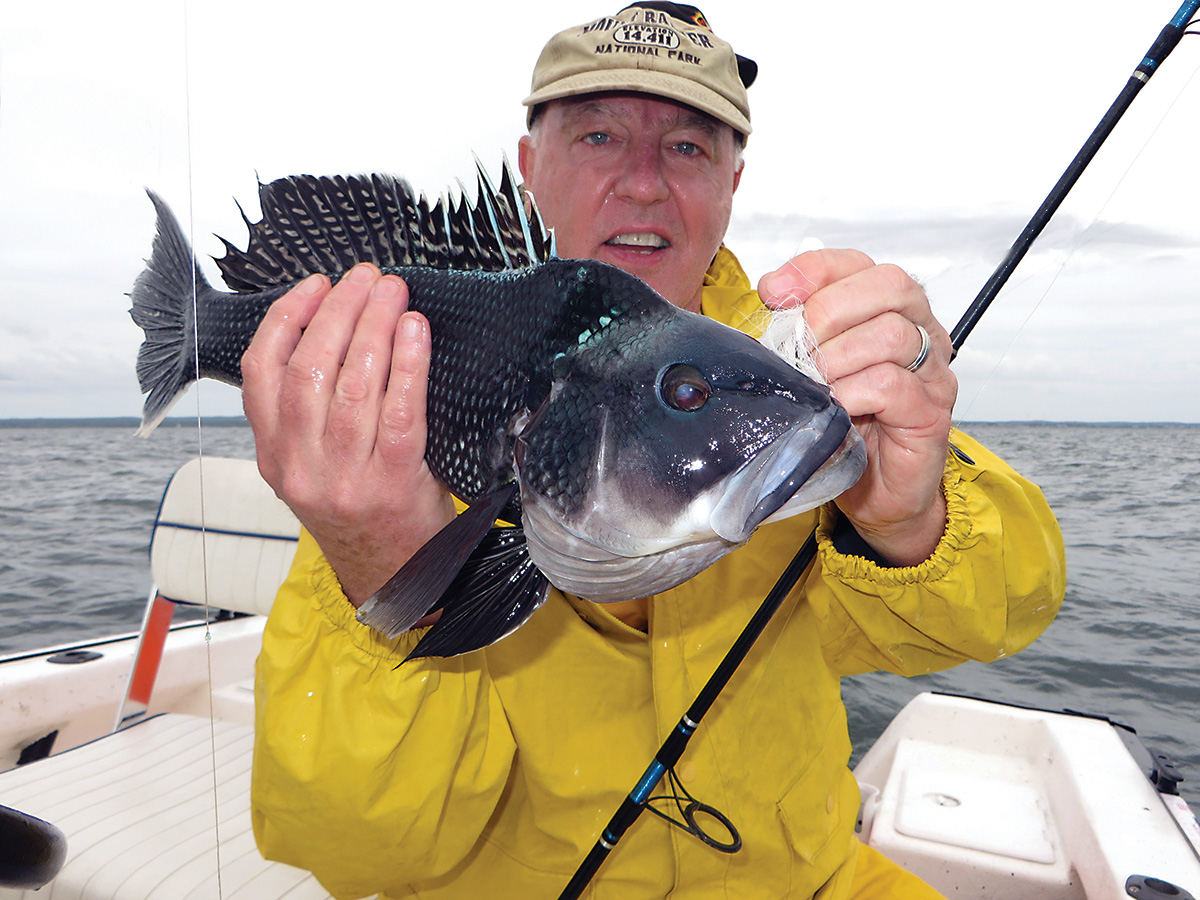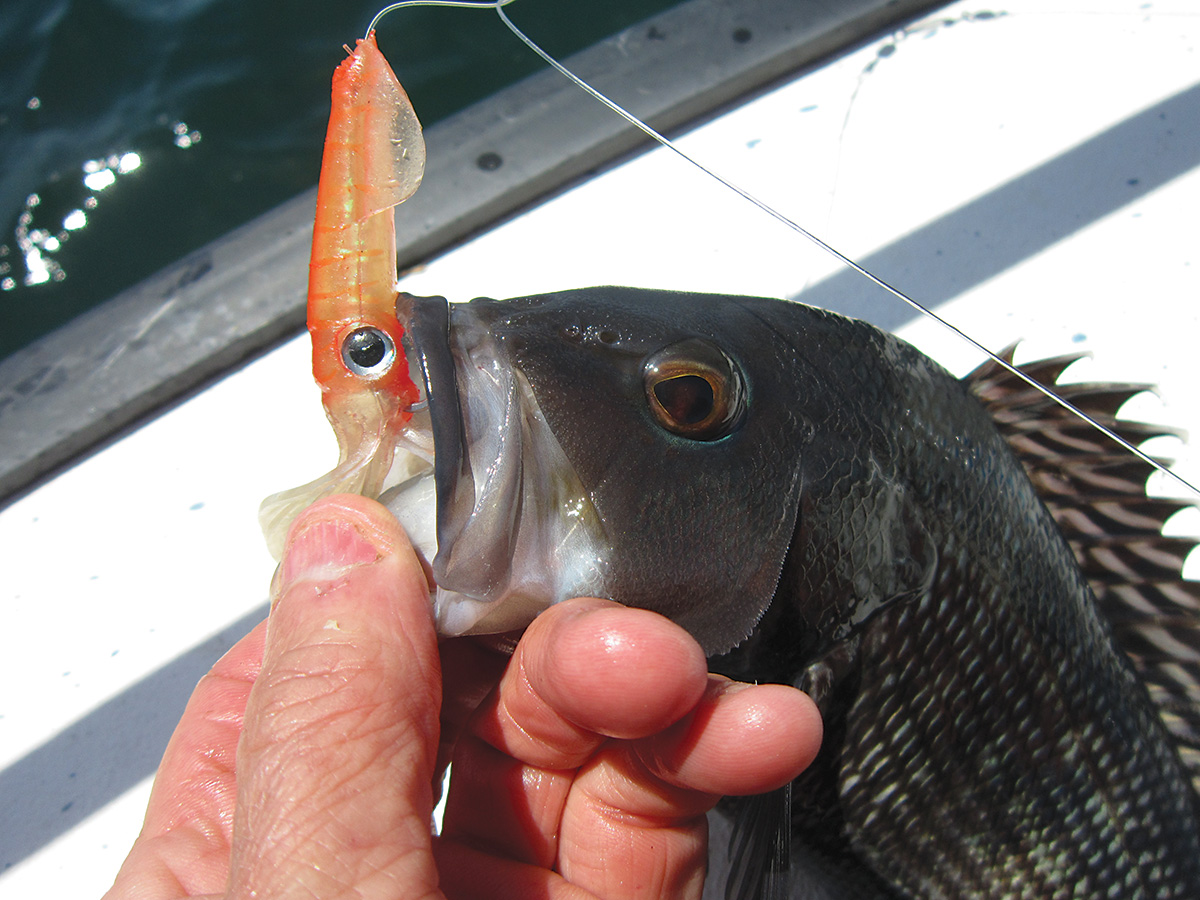
Most experienced black sea bass fishermen will tell you that Buzzards Bay is the very best spot in southern New England to catch these fish in late spring and early summer. This bay is a big expanse of water, about 8 miles wide and 25 miles long. It is a magnet that draws in huge numbers of these black sea bass as well as some of the biggest specimens you will find anywhere. The best fishing usually takes place for about a month from late May into June depending on water temperatures. It’s a boat fisherman’s paradise if you are looking to catch black sea bass at this time of year.
Stick and Move
This place just looks and smells fishy as you motor out to the bay. It’s got everything to attract black sea bass. We tend to put the boat in at the Wareham River and motor for 10 minutes or so out into the western side (Wareham side) of the bay. Right away you begin to notice structure. There are loads of big rocks along the shore that jut into the bay. The bottom composition along here tends to be a mix of gravel and rock. Further out in the middle of the bay you find the Cape Cod Canal dumping out creating loads of current on the west-moving tides. This is also where you will find the deeper water.
On the eastern side of the bay, the Bourne side, you will find ample rocky coves and points. Back rivers along this shoreline flush out into the bay, as well. And, finally, out in the middle of Buzzards Bay you find Cleveland Ledge, a shallow rock ledge in the middle of nowhere marked by a lighthouse. This is the structure that makes up Buzzards Bay, and it draws in loads of baitfish. Hungry, migrating black sea bass can be found just about anywhere, and at times, everywhere in this unique ecosystem.
Our approach to fishing Buzzards Bay is to try numerous spots in search of schools of fish, and it usually doesn’t take long to find them. We tend to drift and jig while keeping a watchful eye on the fishfinder. The fishfinder will absolutely light up when schools of sea bass are found. We search for places that have the most fish and direct our drift right over those spots. Sometimes the fish are found in shallow water under 20 feet, and at other times the big schools of fish are in the deeper 40- to 50-foot depths. If you do not locate fish right away, keep looking as they are there and you will find them.
Active Artificials
While most people consider black sea bass bottom-feeding fish, we have seen instances to the contrary. Last year we found an area in the middle of Buzzards Bay where large numbers of terns were hitting the water with the occasional breaking fish seen beneath them. As it turned out, we had found black sea bass on the surface chasing small sand eels. On some drifts over this clear water spot we could see large groups of fish just a few feet under the boat. In this location we were in 40 feet of water, yet the fish were on or near the surface and actively feeding.
This is a place where artificials shine. I know many fishermen use bait at other times of the year to catch plenty of black sea bass, but the early fish found in Buzzards Bay are aggressive and readily attack artificials including bucktail jigs and skinny metal (tins).
Our technique is to drop the offering to the bottom while drifting and simply bounce the jig up and down. My brother Steve prefers 1- to 2-ounce Spro bucktail jigs. He also likes to use a squid strip (real squid cut into strips) on his jig for added action and scent. On the other hand, I have done extremely well using skinny metal. I like to use either a Kastmaster XL or a Deadly Dick in a 1- to 2-ounce size. These are great imitators of sand eels, an abundant bait at this time of year. Current, wind and drift speed dictate how heavy of a lure is required, but regardless of which you use go as light as possible.

double-headers
of sea bass.
With both lures mentioned above, vertical jigging is the way to go. For the most part, you want to keep your lure near the bottom. Drop the lure to the bottom and when it hits, lock the reel in gear or close the bail. Begin a slow, sweeping upward motion of the rod tip to lift the jig up and then lower it back down. As the boat drifts away and your lure rises, you might need to let out more line to stay near the bottom. I find that most of the hits will come as the lure is settling back down. Pull back on even the slightest resistance. If you are using braided line (We use 30-pound Power Pro.) you should be able to detect even the softest hit.
If landing one fish at a time isn’t enough for you then adding a small teaser above your jig is a great way to double your pleasure. Teasers can be as simple as a single hook with a piece of squid or Gulp!, a curly tail grub, plastic squid or even a lightweight bucktail. Essentially if it moves then it’s got a shot at scoring you a double-header.
Mixed-Bag Options
One other unique aspect to Buzzards Bay in late spring is that it attracts a lot of other fish. Scup, sometimes quite large ones, can be almost as plentiful as the black sea bass and will hit the same lures. We’ve also run into schools of stripers and bluefish that can be found feeding with the black sea bass. We have other rods rigged up with surface lures such as poppers or spooks in case we find blues or stripers on top. We’ve even caught some fluke while working our jigs and metal—you just never know what that next drop might produce.
So, if you are looking for action-plus for black sea bass as well as other species, Buzzards Bay offers early-season boaters about the best action in town. The fish are plentiful and big, and they offer non-stop action for boating fishermen who venture to this location in late spring and early summer. Just remember, if you do land that hefty humphead sea bass, be sure to enter it in the Dream Boat Challenge for your opportunity to win a 23-foot Steiger Craft boat powered by an Evinrude 250HP motor and Lowrance Electronics. See Official Rules for details. Entrants must be subscribers of Fisherman Magazine.
| 2018’s Modified Regs |
|---|
|
As we at The Fisherman have been reporting since mid-winter, recreational black sea bass regulations have been a highly-contested subject. Well, after setting their initial regulations back in March and early April, an appeal was filed by the northern region states of the Atlantic State Marine Fisheries Council (ASMFC) in regards to the disparity in coastwide black sea bass regulations. On May 3, the ASMFC issued a press release granting the appeal with the following modified measures in place. The previously established 15-inch minimum length remains in effect. Massachusetts: 5/19 – 9/12, 5-fish bag limit. |



